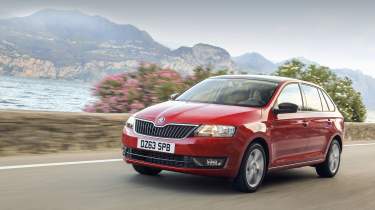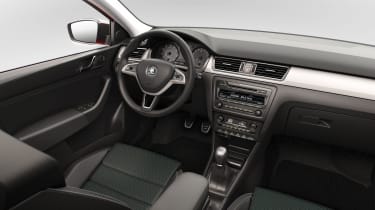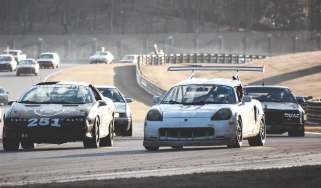Skoda Rapid Spaceback review - hidden talents from value hatch?
Quietly talented hatchback offers up a better drive than you might expect
What is it?
The black sheep of the Skoda family. The Rapid Spaceback exists in a strange limbo between the similarly-styled and slightly cheaper Fabia, and the bigger-booted Rapid – which itself looks like a shrunken Octavia.
It’s pitched as a spacious, value-led family car, but sportier styling than the standard Rapid also promises a more involving drive.
Engine, transmission and 0-60mph time
A 1.2-litre, turbocharged four-cylinder is the peppiest engine you’ll find in a Spaceback if you want a manual gearbox – the available 120bhp 1.4-litre TSI is DSG-only.
Available in 85bhp and 104bhp variants, we tried the more powerful of the pair. Maximum torque of 129lb ft is developed from 1550-4100rpm. It also gets a six-speed manual gearbox to the slower car’s five-speed unit, making better use of the torque spread, and just falls short of a single-figure 0-62mph sprint with a 10.2-second time. Top speed is a respectable 120mph
Technical highlights
While the latest Fabia sits on a platform of updated Polo and MQB parts, the Spaceback makes do with a revision of that Polo platform alone.
That’s hardly a crutch on which the Spaceback has to lean, and the car’s pared-back nature means it’s commendably light – at 1095kg in 1.2 TSI manual trim, it’s only 41kg heavier than the equivalent Fabia, despite being 312mm longer and a touch wider than the supermini.
More reviews
Group tests
- Alpine A290 v Alpine A110 – how much DNA do they really share?
- Ariel Atom 4R v Caterham Seven ‘evo25’: power-to-weight heroes go head-to-head
- Caterham Super Seven 600 v Super Seven 2000
- Levante v T1
- Corvette Stingray v Porsche Cayman GTS v Audi R8 RWD
- Great Ferrari hypercars driven: 288 GTO, F40, F50 and Enzo head-to-head
- Hardcore Ferrari V8 specials go head-to-head
- Lamborghini Aventador Ultimae v Lamborghini Countach
- Lotus Emira v Morgan Plus Four – four-cylinder Brits go head-to-head
- Toyota GR86 v BBR Mazda MX-5: supercharged drop-top battles sports coupe
In-depth reviews
- Abarth 600e 2025 review – Italy gives the Alpine A290 something to worry about
- Alpine A110 review – distinctive, lightweight and unforgettable to drive
- Audi R8 (2015 - 2024) review – the ultimate soft-focus supercar
- Bentley Continental R Mulliner: review, history and specs
- BMW 5-series review – is this still Munich’s anchor model?
- BMW 1-series review – Munich’s Audi A3 rival gains focus
Long term tests
- Abarth 695C Turismo Fast Fleet test – 10,000 miles in the Italian hot hatch
- Alfa Romeo Giulia Veloce Fast Fleet test – 7000 miles in the sharp Italian saloon
- Alpina B10: end of term report
- Alpina B10
- Ford Mustang GT
- Ford Mustang GT
- Ford Mustang GT
- Land Rover Defender 110 Fast Fleet test – 9000 miles in the go-anywhere SUV
- Maserati Ghibli Trofeo Fast Fleet test – 4000 miles in the Ferrari-powered saloon
- Mitsubishi Evo MR 340
Review
- New Aston Martin DBS 770 Ultimate review – 759bhp super-GT driven
- New Bentley Batur 2023 review – can it possibly be worth £1.65m?
- 2023 Chevrolet Corvette C8 Z06 review – the American 911 GT3?
- Kia EV6 GT-Line S prototype review – the EV that shows how it’s done
- BBR Supercharged Mazda MX-5 (ND) 2023 review – tuned 250bhp roadster driven
- MG4 Trophy 2023 review
Reviews
- Abarth 695 75 Anniversario edition 2024 review – a fitting send-off for Abarth’s hot supermini?
- Abarth 500e 2023 review
- AC Cobra 378 Superblower MkIV 2021 review – another V8 Cobra, but with a GM heart this time
- Acura Integra Type S 2024 review – a Honda Civic Type R with added restraint
- Alfa Romeo Giulia 2025 review – get one while you still can
- Alfa Romeo SZ: history, review and specs of an icon
- Alfa Romeo 1750 TBi
- Alpina B3 GT Touring 2025 review – a 190mph alternative to the BMW M3 Touring
Suspension is by MacPherson struts at the front and torsion beam at the rear – and unlike the Fabia, there’s no lowered ‘sport’ suspension option.
What’s it like to drive?
Surprisingly, better than the newer Fabia. Most of that is down to the steering, which has some of the feedback not present in the smaller car. It’s hardly teeming with feel, but there’s enough to telegraph some information from the tyres and the drive is more satisfying as a result.
There’s not much outright grip on the 16in wheels and 215-section tyres, but the chassis balance is safe enough that the inevitable understeer can be quelled with a quick lift. The car always feels on its tip-toes and the relatively soft suspension takes just a moment to settle in corners, but the pliancy is welcome on poor surfaces.
The engine is a highlight of the package. Paired to a sweet-shifting transmission, the TSI’s low-down torque makes the car feel punchy from low revs. Long gearing removes some excitement from a straight-line dash, but the four-pot spins smoothly and there’s even gruff, sporty tone to the exhaust under heavier throttle applications.
Credit should also go to the excellent driving position. The cabin itself is unexciting, but it’s possible to sit relatively low with the wheel suitably close. The simple, glassy cabin pays dividends in terms of visibility too.
Rivals
In terms of interior volume, the Rapid Spaceback matches, and even eclipses most cars in the Focus and Golf class, but pricing is closer to Skoda’s smaller Fabia and its rivals.
It doesn’t have the fun factor of an equivalently-priced Fiesta, and can’t match a cars in the class above for performance, equipment and sophistication, but for a small subset of buyers who need supermini running costs and family car space, the Spaceback is ideal. That they’ll also find a neat chassis and willing engine is just a bonus.
Price
A Spaceback like the 1.2 TSI SE Tech test car starts at £16,340, around £400 more than the DSG-equipped Fabia we drove recently.





